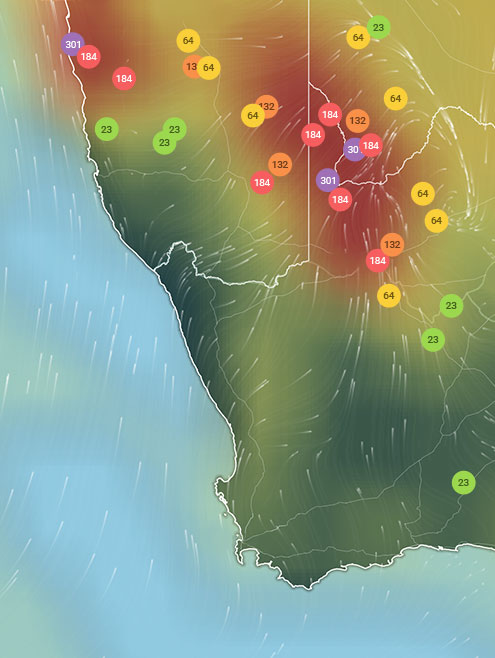Get a monitor and contributor to air quality data in your city.
5.8K people follow this city






AIR QUALITY DATA CONTRIBUTORS
Find out more about contributors and data sources| Weather | Broken clouds |
| Temperature | 91.4°F |
| Humidity | 10% |
| Wind | 5 mp/h |
| Pressure | 29.5 Hg |
| # | city | US AQI |
|---|---|---|
| 1 | San Nicolas de los Garza, Nuevo Leon | 97 |
| 2 | General Escobedo, Nuevo Leon | 82 |
| 3 | Celaya, Guanajuato | 77 |
| 4 | Mexico City, Mexico City | 76 |
| 5 | Santa Catarina, Nuevo Leon | 73 |
| 6 | Monterrey, Nuevo Leon | 69 |
| 7 | San Pedro Garza Garcia, Nuevo Leon | 69 |
| 8 | Salamanca, Guanajuato | 62 |
| 9 | Leon, Guanajuato | 58 |
| 10 | Irapuato, Guanajuato | 56 |
(local time)
SEE WORLD AQI RANKING
| # | station | US AQI |
|---|---|---|
| 1 | Estación San Miguel de Allende | 56 |
(local time)
SEE WORLD AQI RANKINGUS AQI
56
live AQI index
Moderate
| Air pollution level | Air quality index | Main pollutant |
|---|---|---|
| Moderate | 56 US AQI | PM2.5 |
| Pollutants | Concentration | |
|---|---|---|
| PM2.5 | 12µg/m³ | |
PM2.5
x2.4
PM2.5 concentration in San Miguel de Allende is currently 2.4 times the WHO annual air quality guideline value
| Sensitive groups should reduce outdoor exercise | |
| Close your windows to avoid dirty outdoor air GET A MONITOR | |
| Sensitive groups should wear a mask outdoors GET A MASK | |
| Sensitive groups should run an air purifier GET AN AIR PURIFIER |
| Day | Pollution level | Weather | Temperature | Wind |
|---|---|---|---|---|
| Saturday, May 4 | Moderate 77 AQI US | 91.4° 62.6° | ||
| Sunday, May 5 | Moderate 68 AQI US | 89.6° 62.6° | ||
| Monday, May 6 | Moderate 62 AQI US | 91.4° 62.6° | ||
| Today | Moderate 56 AQI US | 91.4° 62.6° | ||
| Wednesday, May 8 | Moderate 60 AQI US | 93.2° 64.4° | ||
| Thursday, May 9 | Moderate 62 AQI US | 95° 64.4° | ||
| Friday, May 10 | Moderate 62 AQI US | 95° 62.6° | ||
| Saturday, May 11 | Moderate 71 AQI US | 93.2° 62.6° | ||
| Sunday, May 12 | Moderate 89 AQI US | 93.2° 62.6° | ||
| Monday, May 13 | Moderate 80 AQI US | 89.6° 60.8° |
Interested in hourly forecast? Get the app
San Miguel de Allende is the principal city in the municipality of San Miguel de Allende, located in the eastern area of Guanajuato, Mexico. It is approximately 274 kilometres from Mexico City.
According to a census that was conducted in 2005, San Miguel de Allende had an estimated population of approximately 140,000 inhabitants.
In December 2021, San Miguel de Allende was experiencing a period of “Moderate” air quality with a US AQI reading of 70. This United States Air Quality Index number is calculated using the levels of six of the most commonly occurring air pollutants, such as nitrogen dioxide, sulphur dioxide, ozone, carbon monoxide and both sizes of particulate matter, which are PM2.5 and PM10. It can then be used as the metric when comparing air quality in other cities around the world. If data is unavailable for all 6 pollutants, a figure can still be calculated by using what figures there are. In San Miguel de Allende, the only pollutant that was measured was PM2.5 with a reading of 21 µg/m³.
When the level of air pollution is classified as “Moderate”, the advice would be to remain indoors as much as possible, closing all doors and windows to prevent more polluted air from entering the rooms. Those of a sensitive nature should limit their time spent outside and should always wear a good quality face mask when doing so. For up-to-date information about air quality, there is an app available from AirVisual.com which is downloadable for all mobile devices. This shows the air quality in real-time.
Looking back at the figures for 2020, published by IQAir.com, it can be seen that for three months of the year, San Miguel de Allende achieved the target figure of 10 µg/m³ or less as recommended by the World Health Organisation (WHO). This happened during the months of May, August and September. July and October saw “Good” air quality with figures between 10.1 and 12 µg/m³. The remaining seven months returned figures from the “Moderate” section with readings between 12.1 and 35.4 µg/m³.
Records pertaining to air pollution were first held in 2019 when a figure of 14 µg/m³ was recorded. The following year of 2020 showed an improvement on this figure with a reading of 12.4 µg/m³. However, this reading may have been affected by the COVID-19 pandemic as many vehicles were no longer in daily use because the offices were closed, in an attempt to halt the spread of the virus. Many factories and non-essential production units were also required to close which removed their emissions from the atmosphere, albeit it on a temporary basis.
In Guanajuato, pollution is serious, where 68% of its soil is eroded, 15 thousand tons of solid waste and special handling are produced every day, it has more than 1.7 million vehicles that travel daily, which are more than 10 years old, which together with the grassland fires generate serious problems to air quality, mainly in the Industrial Corridor.
The verification of automobiles is insufficient in the 46 municipalities, due to the fact that the state's vehicle fleet is 1,700,000 vehicles, of which the vast majority are more than 10 years old, which makes it complicated to pass the verifications as it is highly polluting. A 10-year-old vehicle pollutes up to 10 times more than a more recent one, but in Guanajuato a verification model is being carried out that involves other municipalities, so that model should be reviewed and people trust the program so, you know if your vehicle is in the best condition.
Transportation is an important tool for the development of productive activities in the entity. Derived from daily use, the consumption of fuels increases, which, in turn, generates emissions of pollutants that contribute to the deterioration of environmental quality and accelerate the effects of climate change. The State Government, through the Institute of Ecology of Guanajuato, invites you to participate in the program "SIGA" Clean Transportation Guanajuato, which will reduce pollutants from all means of public and private transportation that run on diesel or gasoline.
A large volume of polluting emissions come from the transportation sector, for this reason vehicle management programs must be updated and measures such as Hoy No Circula should be strengthened. This prevents certain vehicles from entering the city centre on certain days.
These are some recommendations from the Mexican Government to help reduce air pollution;
Scientific evidence indicates that lung damage that is caused by prolonged exposure to lower levels of ozone-polluted air poses the greatest health risk. Averaging ozone levels for eight hours provides a higher level of protection, especially for children and those adults who spend a significant portion of their time working or playing outdoors - a group that is particularly vulnerable to the effects of ozone.
Ground-level ozone is a colourless, odourless pollutant that is formed by a chemical reaction between volatile organic compounds (VOCs) and nitrogen oxides (NOx) in the presence of sunlight. The main sources of VOCs and NOx are mobile sources which include cars, trucks and buses plus farm equipment and construction equipment.
The standard for airborne particulates up to 10 microns in diameter (PM10) remains in effect. But now, Environmental Protection Agency (EPA) says air pollution with smaller particles that are less than 2.5 microns in diameter (PM2.5) is also a health concern. Breathing air polluted with fine particles can have detrimental health effects - including premature death and an increase in respiratory illnesses.
1Contributor
Government Contributor
2 Data sources